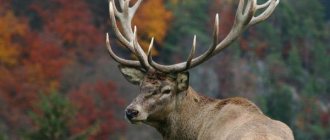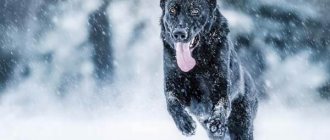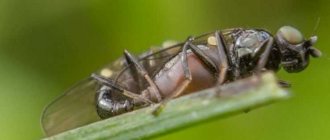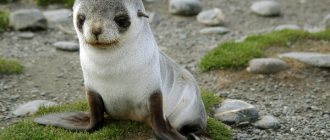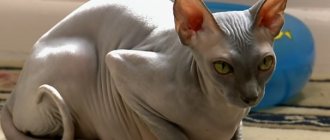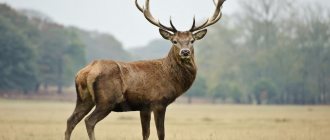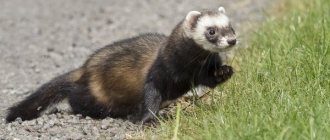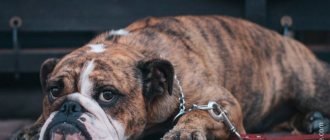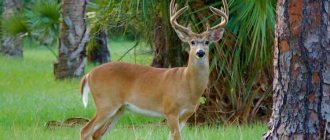- Wild animals
- >>
- Mammals
We are all accustomed to the fact that if it is a deer, then it must have branched antlers, which are often hunted by poachers. But the animal world can bring surprises, and researchers have long been convinced of this. This can be understood by the example of the water deer, which stands apart in the deer family. It is so called because it usually lives only where there is a lot of water. What is a water deer and what exactly makes it so unusual?
Origin of the species and description
Photo: Water deer
Among all the varieties of deer, this species has not yet been studied enough.
There are several reasons for this:
- it is not a very common animal that lives only in a certain region;
- these animals are not a herd species, they usually live alone or in pairs;
- they can only be found in inaccessible places where it is difficult to reach;
- There are not very many such animals left, which also complicates their study.
But although the exact origin of the water deer is unknown, it is safe to say that its habitat since ancient times has been the territory of Eastern China and Korea. There are 7 subspecies of this animal in total. The most common is the Siberian one, but the Kashmiri water deer is very rare.
In appearance, the water deer is somewhat reminiscent of an ordinary roe deer. Even its size does not reach any antlered deer. There are not very many individuals of this animal left. Seeing them in the wild is not very easy because they are usually nocturnal. And during the daytime they prefer to rest somewhere in the bushes. What is their peculiarity, why did scientists identify water deer as a separate species?
Genetic diversity[edit]
Mitochondrial DNA of samples from the native Chinese population and the introduced UK population was analyzed to infer each population's genetic structure and genetic diversity. It was found that the UK population exhibits lower levels of genetic diversity and that there is genetic differentiation between native and introduced populations. [26] It was also found that the original population of British deer was probably extinct. [26] This has implications for the conservation of diverse populations, especially because Hydropotes inermis
classified as vulnerable in its native range according to the IUCN Red List.
Appearance and features
Photo: Animal water deer
Although this is a deer, it still has its own characteristics that are unique to this species:
- lack of horn on the head;
- the presence of two large fangs;
- small sizes.
The water deer does not have antlers at all. And this applies to both young individuals and older males and females. But he has two fangs that protrude from under his upper lip. In adult individuals, they can reach up to 8 cm. They are curved, which does not prevent the animal from eating grass. This is the main means of protection from various predators, which are abundant in dense thickets.
But it is necessary to pay attention to the fact that only males have fangs; females do not have them. Scientists have learned to determine the lifespan of these animals not only by the length of the fangs, but also by the degree of their curvature. The water deer can control them using its facial muscles.
Video: Water deer
When the feeding process is underway, they practically hide. But when the deer sees danger, they immediately appear and represent a formidable weapon. Thanks to this feature, this animal received another name - the vampire deer.
There are several main natural characteristics of the water deer:
- body length can be from 80 to 100 cm;
- height does not exceed 50-55 cm;
- body weight is small, usually 12-15 kg;
- the tail is small, can only be seen if you look closely.
The coat is brownish-brown, and the neck and belly are lighter. The wool is a little rough to the touch. Depending on the time of year, its size changes. Water deer usually shed their coat during the summer, causing their fur to become short. And in winter, when it gets cold, the animal’s body is covered with larger and fluffier hair. As for the undercoat, it is practically absent.
The eyes of the water deer are not only large, but also dark. And there is a kind of ring around them, which makes them look even larger. Compared to the head, the ears appear large. Thanks to them, the animal can hear well, which allows it to detect danger in time. His legs are not only high, but also thin. This animal lives no more than 10-12 years. And where can it be found, what territory is usually called its homeland?
Branched horns
Reindeer are the only ones in the deer family that have antlers on both males and females. The surface of the horns is perfectly smooth. As a rule, the horns are asymmetrical. Their shade ranges from brown to light beige. Reindeer antlers are fragile because their bone material is quite loose. The antlers of young reindeer contain very valuable medicinal substances. The extract isolated from them is used for the manufacture of medications that have a tonic and immunostimulating effect.
The total length of the horns can reach 1.5 m, span up to 1.2 m, and their weight is about 11-12 kg. On very large males, the antlers can weigh almost 20 kg.
Where does the water deer live?
Photo: Chinese water deer
Typically, water deer can be found in Eastern China and Korea. If this is China, then most often we are talking about forest areas north of the Yangtze Valley. But recently a message appeared that one of the subspecies of water deer was discovered in Afghanistan. We are talking about a very rare Kashmiri species. Although this animal lived here before, it has not appeared since 1948.
Water deer do not like to change their habitat, so we can say that these animals do not migrate. But with the help of man, it appeared on the territory of not only France and Australia, but also Great Britain. It has taken root here well, although the climate is completely different, not the same as in Korea. These artiodactyls are also often found in zoos. But this is no longer a natural habitat.
It is very important for the water deer that the area where it lives is wet. He loves to be on the banks of rivers and lakes, where there are large thickets. The tall reeds are his favorite place. But very often it moves onto plowed and sown fields, which causes big problems for farmers.
Nutrition
The water deer's main diet consists of grasses, sedges, reeds and other wetland plants. The availability of food depends on the habitat. Deer inhabiting wetlands have a more varied diet than those living in grasslands. Sometimes grasslands are burned to stimulate the development of new shoots.
What does water deer eat?
Photo: Water deer
Although the water deer looks menacing when it exposes its two fangs, it is still not a predatory animal. It feeds only on plant foods, which are abundant in the Yangtze River Delta. There is a lot of it here at any time of the year. And given that winter in this region does not pose any problems for vegetation, this animal does not try to go anywhere.
Drought does not pose any problems for water deer. If somewhere on the river bank there is little food, the animal can calmly swim to another place where there is more vegetation. The Yangtze River Delta has many small islands covered with vegetation. If necessary, water deer can easily get here.
His favorite delicacy is juicy grass, as well as young shoots of bushes. But if there is not enough grass, it can switch to tree leaves. Water deer eat large quantities of sedge and reeds. To add variety to her dishes, she occasionally eats mushrooms.
Apparently, the body of this animal requires some trace elements, as well as protein. Periodically, it raids cultivated fields where rice grows. It eats everything that comes in its way, not only various weeds, but also grains. So this animal brings some harm to agriculture.
Links[edit]
- Jump up
↑ Harris, R. B. & Duckworth, J. W. (2008).
"Hydropotes inermis". IUCN Red List of Threatened Species
.
2008
. Retrieved April 8, 2009 .URL of old form The database entry includes a brief rationale for why the species is vulnerable. - Jump up
↑ Grubb, P. (2005). "Order of artiodactyls". In Wilson, Delaware; Reader, D. M. (ed.). Mammal Species of the World: A Taxonomic and Geographical Guide (3rd ed.). Johns Hopkins University Press. item 671. ISBN. 978-0-8018-8221-0. OCLC 62265494. - Douzery, E.; Randy, E. (November 1997). "The mitochondrial control region of Cervidae: evolutionary patterns and phylogenetic content". Molecular Biology and Evolution
.
14
(11): 1154–1166. DOI: 10.1093/oxfordjournals.molbev.a025725. ISSN 0737-4038. PMID 9364773. - Randi, E.; Mucci, N.; Pierpaoli, M.; Douzery, E. (1998). "New phylogenetic insights into Cervidae (Artiodactyla) provided by a mitochondrial cytochrome b gene". Proceedings of the Royal Society B: Biological Sciences
.
265
(1398):793–801. DOI: 10.1098/rspb.1998.0362. PMC 1689037. PMID 9628037. - ↑
Bailly, Anatole (1 January 1981).
Abrégé du dictionnaire grec français
. Paris: Hachette. ISBN 2010035283. OCLC 461974285. - ↑
Bailly, Anatole.
"Greek-French Dictionary Online". www.tabularium.be
. Retrieved December 31, 2022. - Gaffiot, Felix (1934). Dictionnaire illustré Latin-Français (in French). Paris: Librairie Hachette. item 810. Retrieved December 31, 2022.
- ↑
Park, H., Woo, D., Choi, T. and Hong, S., 2022. Assessing the behavioral response of Korean water deer (Hydropotes inermis argyropus) to different fence heights. [online] Available at: < https://www.mdpi.com/2076-2615/11/4/938/htm > [accessed 26 March 2022] - "Hydropotes inermis (Water deer)". IUCN Red List of Threatened Species
. November 17, 2014 November 17, 2014 . Retrieved June 4, 2022. URL of old form - "Efforts to restore the Chinese water deer population in Shanghai, China". Retrieved September 19, 2022.
- "Archival copy". Archived from the original on November 5, 2014. Retrieved November 4, 2014.CS1 maint: archived copy as title (link)
- "European mammals - non-native and introduced species". hows.org.uk. Retrieved June 4, 2022.
- "국제 멸종 위기 종 고라니, 국내선 왜 민폐 동물 됐을까". news.joins.com. January 22, 2018. Retrieved July 3, 2022.
- "17 만 마리씩 죽는 고라니... 어쩌다 '민폐 동물' 이 됐나" . news.joins.com. January 21, 2018. Retrieved July 3, 2022.
- "Wildlife Survey 2022" (PDF). me.go.kr. October 9, 2022. Retrieved July 3, 2022.
- "' 농가 피해' 야생 동물 포획 급증..." 사체 처리 는 제각각 » » . yonhapnews.co.kr. October 9, 2022. Retrieved July 3, 2022.
- "야생 동물 포획 수 정리" . March 4, 2022. Retrieved December 8, 2018.
- “차로 치고 새끼 유괴 하고… 고라니 의 잔인한 봄” . ecotopia.hani.co.kr. May 6, 2016. Retrieved July 3, 2022.
- "Deer distribution of Chinese water deer 2000–2007" (PDF). bds.org.uk. Retrieved December 19, 2010.
- Apollonio, Marco; Andersen, Reidar; Putman, Rory, ed. (2010). "20 - Ungulates and their maintenance in France." European ungulates and their management in the 21st century
. Cambridge: Cambridge University Press. item 448. ISBN 978-0-521-76061-4. - ^ abcdef "Hydropotes inermis (Chinese water deer)". Animal Diversity Network. Retrieved August 27, 2022.
- "Species - Chinese water deer". Mammal Society. Retrieved October 20, 2022.
- Sun, Lixing, Bing Xiao, and Nianhua Dai. "Scent behavior in male Chinese water deer." Acta theriologica 39.2 (1994): 177-184.
- ↑
Geist, Valerius (30 June 2013). “Chinese water deer | mammal". Britannica.com. Retrieved June 4, 2022. - ↑
Liz Langley (December 25, 2014). "Krampus's buddy? The fanged vampire deer "explained". National Geographic. Retrieved April 8, 2016. - ^ab Rory Putman; Nicholas Dunn; Andy Zhang; Ming Chen; Christian Mikel; Vincent Savolainen (2021). "Conservation of the genetics of native and European Chinese water deer (Hydropotes inermis)". Zoological Journal of the Linnean Society
.
191
(4):1181–1191. DOI: 10.1093/zolinnean/zlaa076.
Features of character and lifestyle
Photo: Water deer animal
Males and females unite only during the rut, and then disperse again. In nature, it is more convenient for such an animal to live on its own. Moreover, there is a lot of food in the habitat. And there aren’t too many dangerous predators here, so you can fight them alone.
But if danger approaches, most often the water deer shows why it got its name, as it simply hides in the pond. These animals are very good swimmers; they can swim several kilometers at a time without going ashore. When entering a new place, a deer tries to immediately mark its territory. This means that no one else has the right to enter here.
They mark territories in several ways:
- In males, special glands can be found between the hooves. It produces a liquid that has a strong odor;
- In a new territory, the animal tries to immediately walk around the entire perimeter. At the same time, a liquid with an odor is not only released from the hooves, but the deer immediately plucks the grass;
- bites tree branches, and then places them in different places around the perimeter. The animal always wets the branches with its saliva.
The water deer does all this to show that this is his territory, and no one else has the right to enter here. And if any deer nevertheless violates the established border, the owner of this territory, without any hesitation, immediately uses his formidable weapon in the form of fangs.
Behavior
Water deer are asocial animals that prefer a solitary lifestyle. Males are territorial and mark their territories with excrement and urine. They also nibble off pieces of vegetation to mark boundaries. Although males have long fangs, they are not related to carnivores. They use their fangs as weapons during territorial and mating fights. The losing male is banished from the territory and cannot mate with any female within the boundaries.
Females only exhibit territorial behavior during the breeding season, but when the season ends they can be seen wandering into other territories. Female water deer behave aggressively towards other deer during pregnancy or after giving birth to their young. They make a barking sound, which is interpreted as an alarm signal.
Didn't find what you were looking for? Use the site search form
Did you like the article? Leave a comment and share with your friends
Social structure and reproduction
Photo: Water deer from China
The rut of water deer begins in winter, in December. This allows the male and female to unite for the “wedding” period. But mating occurs not at the request of the male, but of the female. So it turns out that matriarchy still reigns here. The female makes clicking or whistling sounds. By this she shows the male that she is now ready to mate.
But you still need to fight for the female, you need to win her. The thing is that with her clicking she simply invites the male. And how many of them will come running to this call is no longer known. They must enter into a tournament among themselves, which turns into a real battle, a massacre. Only one winner can receive such a valuable prize.
The battle is brutal because each male uses his fangs, which turn into sharp knives. Each of them tries to rip open the opponent's neck or belly. The defeated person is then left with large bleeding wounds.
The winner and the “prize” form a pair for a while and eat together. The female's pregnancy lasts 6 months. As a result, not one fawn, but several may appear. So far there is no exact confirmed data, but there is oral information from residents living in the habitat of such deer that the offspring can even be 5-6 cubs.
Until a week after birth, they do not show up, hiding in bushes or dense thickets. But most often the doe tries to give birth to them under the cover of trees. After 7-8 days, the fawns already try to follow their mother and begin to learn to eat not only milk, but also young grass.
Mating season
Despite their solitary lifestyle, the breeding season for water deer is very vigorous. In December, males begin to become more active and look for females for fertilization. Here they find use for their long fangs. Males organize tournaments to win the heart of the female. Battles take place with bloodshed. Each male tries to hit his opponent with his fangs, trying to bring him to the ground. During mating, you can often hear both males and females barking. The female's pregnancy lasts no more than 6 months and 1-3 fawns are born. For the first days, the babies do not leave their hiding places, and then they begin to follow their mother.
This is interesting: Types and subspecies of tigers: list, description and photo
Natural enemies of water deer
Photo: Water deer from China
The water deer does not have many natural enemies. And all because this animal runs fast, swims well and knows how to find natural shelters. When it sees danger, it immediately tries, if there is a body of water nearby, to quickly rush there. Above the water, when a deer swims, you can only notice its ears, nostrils and eyes. This allows him to observe where the danger is.
The main enemy of this animal is the crested eagle. It attacks not only young but also adults. It is not difficult for him to cope with a deer whose weight does not exceed 10-13 kg. The animal has no way to defend itself, since the eagle attacks from above. So he has to flee. But deer don't sit in the water waiting for the danger to pass. It swims or moves along the bottom of the reservoir, if possible, to the place where it can hide.
We are talking about thickets of trees that come close to the reservoir. Under their crown he will be completely safe. Another natural danger to water deer is drought. But he can easily cope with it, since he tries to stay close to rivers and lakes. If necessary, it can swim to another place.
Etymology[edit]
- The genus name Hydropotes
comes from two ancient Greek words ὕδωρ (
húdōr
), meaning "water", and ποτής (
potḗs
), meaning "fact of drinking", [5] [6] and indicates the preference of this cervid for rivers and swamps. - The etymology of the species name corresponds to the Latin word inermis,
meaning "
unarmed, defenseless", which
is formed from the prefix "
in-",
meaning "
without",
and the base "
arma",
meaning
defensive weapon, armor
,[7] and refers to the fact that that the water deer is without horns.
Population and species status
Photo: Water deer
Although the population of water deer is stable, especially if we take into account the Chinese variety, there is still a certain danger of extinction of this animal. And all because under natural conditions it lives only in one region.
This deer does not like long journeys. And if, due to drought, it had to move to another territory, then again, after the rainy season, it tries to return to its original habitat. When encountering predators or competitors for territory along the way, water deer can become aggressive. Or, on the contrary, show excellent diplomatic skills.
These animals can not only fight, but also talk to each other. They make sounds that are more like barking. They bark not only at other animals, but also at people. The water deer stands out among all its relatives for one more feature - its solitary lifestyle. These animals never gather in herds; they are distinguished by their timidity. Because of this lifestyle, the animal is still poorly studied.
Lifestyle
Water deer are distinguished by their asocial character. Relationships with relatives are established only during the breeding season. These amazing animals are extremely jealous of their own territory. In order to protect their place from others, they mark their space. Between the toes of water deer there are special glands with a characteristic odor that help repel uninvited guests. Water deer communicate using a characteristic sound similar to a dog barking.
Differences from immediate relatives
Roe deer, muntjac and moose, even though they belong to the same family as deer, are not species of these animals, but only their close relatives. And sometimes these noble animals are confused with other representatives of the fauna, such as pronghorn antelope. There are such features of deer that distinguish them from other horned artiodactyls:
The main difference between deer and bovids is the structure of the horns. In bovids, they are bony processes of the skull that grow throughout life and in most species are present in both males and females. Deer antlers have a much more complex structure: they are tubular, filled with blood and covered with thin skin, and are also grown and shed by animals many times during their lives.- Elk antlers, unlike deer antlers, tend to grow wider rather than higher. In addition, moose have thinner and higher legs.
- The horns of roe deer, in turn, are rough and covered with tubercles, and also do not have branches, so it is quite difficult to confuse them with deer, despite their close relationship.
Deer are very diverse: huge and small, with luxurious antlers and antlerless, plain, spotted and with a wide variety of color features, inhabiting fields, forests and mountains in all climatic zones. All of them, be it domesticated caribou, Indian axis, David's deer, which disappeared from the wild, or any other species, are unique in their own way, beautiful, worthy of attention, study and protection.
Habitat
Recommended by topic
Fox Panda Lynx
Representatives of deer live almost all over the world. Some subspecies have chosen the territories of Europe and Asia, others have settled throughout South and North America. You can meet deer in Australia, New Zealand and even at the North Pole.
Deer are quite unpretentious animals and quickly adapt to climatic conditions and other related factors. The main condition for the life of deer is the availability of food in summer and winter.
Representatives of the family prefer to settle in forests, but feel good in flat, swampy and rocky areas. Almost all species try to choose areas near water bodies and natural pastures.
In the summer, deer look for grazing places in sparse forests or on plains, and in winter they go into the thicket. In forested areas it is easier to get food, since the layer of snow is relatively small and there are no deep snowdrifts or strong crust.

